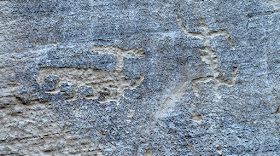From Wiki: El Morro National Monument is located on an ancient east-west trail in western New Mexico. The main feature of this National Monument is a great sandstone promontory with a pool of water at its base.
As a shaded oasis in the western U.S. desert, this site has seen many centuries of travelers. The remains of a mesa top pueblo are atop the promontory where between about 1275 to 1350 AD, up to 1500 people lived in this 875 room pueblo. The Spaniard explorers called it El Morro (The Headland). The Zuni Indians call it "A'ts'ina" (Place of writings on the rock). Anglo-Americans called it Inscription Rock. Travelers left signatures, names, dates, and stories of their treks. While some of the inscriptions are fading, there are still many that can be seen today, some dating to the 17th century. Among the Anglo-American emigrants who left their names there in 1858 were several members of the Rose-Baley Party, including Leonard Rose and John Udell. Some petroglyphs and carvings were made by the Ancestral Puebloan centuries before Europeans started making their mark. In 1906, U.S. federal law prohibited further carving.
We visited here on May 21, 2015. On the way here, and just a few miles before this place, we stopped by El Malpais Visitor's Center and spoke briefly with a Zuni Indian Park Ranger and provided some details about the Monument. From NPS website: The primeval black basalt terrain of El Malpais was created by volcanic forces over the past million years. Molten lava spread out over the high desert from dozens of eruptions to create cinder cones, shield volcanos, collapses, trenches, caves, and other eerie formations. This stark landscape preserves one of the best continuous geologic records of volcanism on the planet.
We took the short .5 mile walk around the base of the El Morro and snapped off several photos of the "graffiti" left by the early pioneers.
Note the lonely Ponderosa Pine above struggling for survival.
El Morro National Monument is a fascinating mixture of both human and natural history. Rising 200 feet above the valley floor, this massive sandstone bluff was a welcome landmark for weary travelers. A reliable waterhole hidden at its base made El Morro (or Inscription Rock) a popular campsite. Beginning in the late 1500s Spanish, and later, Americans passed by El Morro. While they rested in its shade and drank from the pool, many carved their signatures, dates, and messages. Before the Spanish, petroglyphs were inscribed by Ancestral Puebloans living on top of the bluff over 700 years ago. The softness of the sandstone made it easy to carve pictures, names, dates and messages. Ironically, that is also the reason that the famous inscriptions are slowly disappearing. Today, El Morro National Monument protects over 2,000 inscriptions and petroglyphs, as well as Ancestral Puebloan ruins.
I could offer comments about the many inscriptions on these walls, but I'll let the storyboards tell say what the pictures portray, hopefully.
The falls of the rainwater from El Morro is naturally collected here in this "tank" and provided life-sustaining water for many a traveler and their rides.
...A large crevasse between the canyon walls..
To enlarge any photo, just click on it.
Well, that about wraps up our ride down Route 53 in New Mexico as we head toward Arizona on our way eventually to the US Open Golf at Chambers Bay in Tacoma, WA in June. So, till the next blog, RVing Beach Bums signing off. This blog was written contemporaneously on July 4, 2015 from NAS Whidbey Island, WA.
























































No comments:
Post a Comment